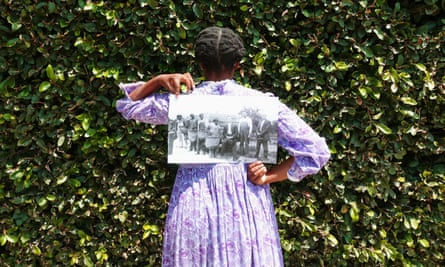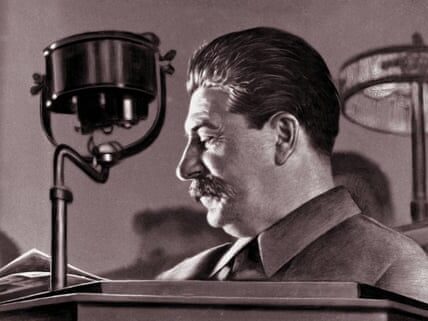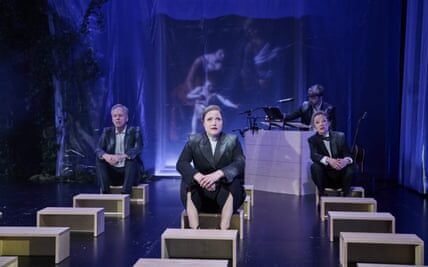Widening the Lens: using photography to re-examine our environment
The striking collection of photographic art presented in the Carnegie Museum of Art’s Widening the Lens is very much a revision of the long tradition of landscape photography in the US. It may be very directly revising – as in AK Burns’s reinvention of landscape photographs literally ripped from photo books – or it may be much more subtly so, as with Sam Contis’s careful deconstructions of the iconography of the American west. However so, this is a show very much about counter-narratives, hidden histories, reinscription, reinvention and revision.
Borne of a desire to consider how our relationship with images has shifted as photography has become shockingly more ubiquitous and prolific, Widening the Lens looks at photographs both as singular objects as well as pieces integrated into larger objects. It is a show that strives to be responsive to how the lines between photography and other artistic media have become blurred, and one that seeks to imagine what environmental photography looks like now.
Appropriate to this long look at imagery and landscape, Widening the Lens is grouped into four major through lines: colonial legacies, landscape as a memorial site, human adaptability and mobility, and environmental anxiety. These themes take us temporally through the past, present and future, and they offer useful ways to draw interconnections between the sometimes cacophonous array of artwork brought together for this exhibition. “We’re trying to tell these stories that have both happened in history,” said Dan Leers, exhibition curator, “but also hopefully charting some possible courses forward for humanity.”

Examining Xaviera Simmons’s Sundown series, named for so-called sundown towns, which become extremely unsafe for African Americans after dark, one finds self-portraits in which the artist inhabits a carefully arranged tableaux of elements that conjures landscapes where Black people were exploited. In each, she holds up various images toward the camera, inviting us to imagine how the imagistic history of the United States has shaped the identities of her subjects. One such images reads: “The myth of the American Frontier still shapes US racial divides,” suggesting that the deep history of the American landscape and its representation is still very live in contemporary struggles over inequality.
One standout collection from the show are photographs taken from Justine Kurland’s now 20-year-old series Girl Pictures. In it, Kurland envisions a world of teenage girl runaways in which her protagonists are seen boldly transiting through various natural landscapes, both wildernesses and liminal zones at the edges of urban areas. It is a narrative of how these girls might transit the land in a world much different and much safer for them to grow up in.
“It’s not documentary, not a re-enactment, it’s about using photography to build a world that seemed more equitable and just,” Kurland told me. She shared that part of the drive to create Girl Pictures came out of the problematic history of landscape photography, where the camera – most often held my a male photographer – has been used to conquer and dominate. By contrast, she aimed to create a landscape that the girls were not seen as settling into, but rather one in which the landscape was holding them, offering a sense of interdependency.

The photos in Girl Pictures are first striking for the simple beauty that Kurland finds in the landscapes; her iconography comes across as gentle and intimate, these places seen more in bite-sized chunks where the girls can find moments of refuge, connection, strength and play. Forest, in particular, with the two large tree trunks that frame the image, offering a place of restfulness and connection for the girls, and with the gentle layers of light drifting off into the background depths, creates a feeling of peace and harmony, very much suggesting the holding that Kurland wants her landscapes to be doing.
“Even though Kurland’s images are some of the earliest photographs in the show,” Leers told me, “these photos feel so present and contemporary in so many ways. They’re what a world might look like populated by strong, young, independent women. It’s really exciting.” The selections from Girl Pictures are easily one of the standout groupings from Widening the Lens, and a strong reason in and of themselves to see this exhibition.
Lucy Raven’s shadowgrams, which were made by firing objects filled with magnesium, aluminum and gravel at pieces of photosensitive paper, come across as mysterious and somewhat opaque. (It was probably not lost on Raven that shadowgrams were used to advance weapons and flight technologies, two key components in subduing the west.) These pieces are a very different take on the photographic medium, one that challenges the idea of representation itself, and that pushes Widening the Lens into very different territory.

Another aspect of Widening the Lens is the six-part podcast that will be released in conjunction with it. Based around themes like myth-making, dominion and impressions, the podcast welcomes guests including artists, curators, geologists, film-makers, writers, poets and more. It’s hosted by tennis great Venus Williams, whom Leers explained was picked after a lengthy search for the perfect individual to partner with. “We wanted someone with a broader reach,” he shared. “In conversation with Williams and her team, we understood she’s very deeply engaged with the contemporary arts world. She’s very engaged in thinking about the role that arts can play.”
The podcast is a part of a wider ambition taken on by the Carnegie Museum of Art to engage with audiences who might never make it through the museum’s doors to attend Widening the Lens in person. According to Leers, these goals had been sparked by the period of disconnect during the Covid shutdown. “We need to be more responsive in meeting our audiences where they are,” he said. “We want to give everyone a chance to try and engage with all of our projects.”
Widening the Lens is a very diverse body of work, almost imbuing the show with a kind of “everything but the kitchen sink” feeling, and its capaciousness and openness feels very appropriate for an exhibition trying to re-examine the rules for the American landscape. It is also very much one that is about wondering how our pasts, both longer and more recent, will continue to evolve forward into the future. It is Leers’s hope that anyone who visits Widening the Lens will take some time to consider the question of impacts, and let that inform their actions in the future. “I hope audiences might think for even one extra second how their actions today are going to impact my surroundings now and in the future,” Leers said. “I hope they’ll understand that those impacts can magnify, expand, resonate in the future.”
-
Widening the Lens: Photography, Ecology, and the Contemporary Landscape is now on display at the Carnegie Museum of Art in Pennsylvania until 12 January 2025
Source: theguardian.com



